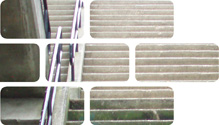
Concrete Inert 17 01 01
Concrete is a strong matrix of bound materials to suit a range of structural and non-structural uses. Concrete is cast in various forms and thicknesses, depending on the specification required. It is of varying quality, strength and finish depending on the desired function and performance. Some concrete materials have a finished surface to suit the architectural finish.
Usage & Probable Locations
Concrete has many uses in construction, as it can be formed into almost any shape. It is commonly used as a structural element, be it a beam, column, floor slab, staircase, rafter, portal frame, foundation or service route. Concrete acts as the main frame and lift shafts in many buildings, for foundations, as piles, as walls, in panel systems, along roads and in pavements.
Personal Protective Equipment
PPE requirements indicated are for guidance purposes only. DRIDS has identified the PPE that is mandatory on all demolition projects and ones that may be required subject to site specific Risk Assessment & Method Statement (RAMS). Hover over the icon to determine the types of PPE required for the removal of this material.
Removal, Segregation & Storage
Concrete sections that are destined for reuse should be deconstructed, segregated and stored carefully and safely, to ensure their integrity and good condition. They should be stored flat on timber skids to prevent cracking and away from plant movements to prevent damage. Crushed concrete that is destined for recycling should have the steel reinforcement removed and the majority of contaminants removed to suit the quality protocol for recycled aggregates. Concrete buildings, structures and infrastructure should be demolished using suitable plant and attachments and stored in piles of crushed materials that have been screened. There is no need to store concrete inside a building or under cover as it is robust against inclement weather.
Tools
Fixtures, Fittings & Connections
Concrete has been traditionally cast in place, often using steel mesh and bars and occasionally pre-stressing cables for reinforcement. Some products are precast at a factory, then grouted into position with other concrete, steel or timber products. Some products such as lintels, blocks and pavement slabs require no fixings, they will be laid in place using mortar, screed or other binding agent. Concrete is sometimes painted or coated with bitumen in harsh environments such as farms, sewage works and water environments. Structural elements will sometimes be coated in fire retardant paints or lined with fire resistant materials.
Health & Safety
Subject to task-specific Risk Assessment & Method Statement (RAMS). Wear gloves and respiratory protective equipment (where necessary) when handling concrete products, crushed materials, fire retardant materials or paints to prevent irritation, cuts and abrasion. Use eye protection when using hand tools. Limit hand, arm and whole body vibration when using air tools. Only use 360 plant and attachments if appropriately trained. Be aware of old, arched, pre-tensioned or post-tensioned concrete structures and undertake controlled demolition as determined by RAMS. Refer to NFDC internal Guidance on Concrete Structures.










